 Machete Maidens Unleashed! is a mandatory look at grindhouse moviemaking during the untamed 1970s. 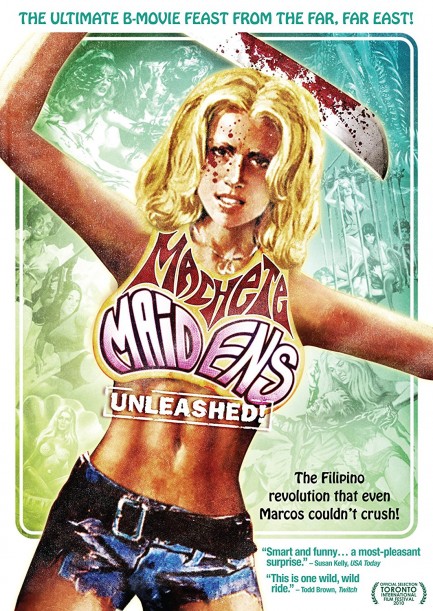
Machete Maidens Unleashed! is a film we've watched a few times, and whenever a movie racks up multiple viewings we think it needs to be highlighted. It's a fast paced documentary about the wave of low budget exploitation flicks made in the Philippines from the late ’60s through the ’70s. We weren't old enough to see any of them during the actual grindhouse era, but caught them in later years, and one reason we came up with this website was for the opportunity to riff on these types of flicks. Over the last decade-plus we've had the pleasure of writing about entertaining dreck like Savage Sisters, The Big Doll House, Night of the Cobra Woman, and Cleopatra Wong.
Built around interviews with stars such as Pam Grier, Sid Haig, Margaret Markov, Gloria Hendry, and directors/producers like Eddie Romero, Jack Hill, Joe Dante, and Roger Corman, Machete Maidens Unleashed! is an insider's look at a unique era in cinema history. It compellingly juxtaposes snippets of cinematic insanity against clips of the performers involved laughing over the craziness of it all. While the movies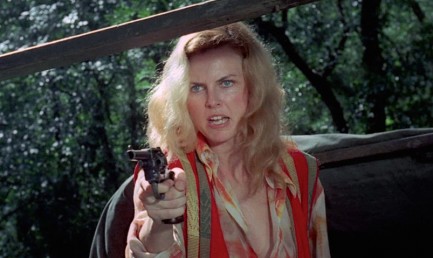 discussed often fall into the category of sexploitation, at the time they were also considered an adjunct of the women's liberation movement—a point made by a couple of the actresses interviewed. Coming out of the sexually repressive decades of the fifties and early sixties, nudity was seen as a rebuke to patriarchal control. discussed often fall into the category of sexploitation, at the time they were also considered an adjunct of the women's liberation movement—a point made by a couple of the actresses interviewed. Coming out of the sexually repressive decades of the fifties and early sixties, nudity was seen as a rebuke to patriarchal control.
Covering productions ranging from 1964's The Walls of Hell to 1979's big budget war flick Apocalypse Now, this is a wide ranging documentary, and by far the most entertaining one on the subject matter we've seen. What with our website's Philippine provenance, and with PSGP having spent a couple of years in Guatemala, another country where life was cheap but fun was unparalleled, this also hit us directly in the nostalgia gland (PSGP feels like the only reason these films weren't made in Guatemala is because everyone actually would have been murdered, instead of just thinking they would). All the interviewees seem to understand that they're from an extinct breed of very brave film performers, making entertainment for audiences ready to see absolutely anything happen. It sometimes seems that modern audiences have forgotten that the filmmaker is not the material, and the actor is not his or her character. The message comes through strongly here that movies are simply make believe. The creators may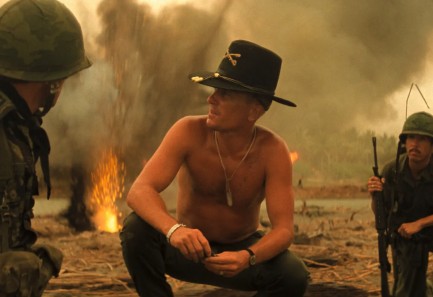 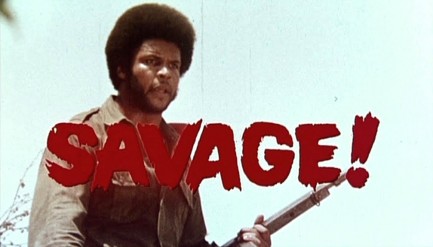 want to outrage, or teach, or push censorship envelopes, or illuminate themes that leave audiences enriched in some way, but it's still just a job they perform before going home to their real lives. We wouldn't be surprised if some of the interviewees now feel they'd been traumatized, but during this movie, at least, they shrug off the difficulties of filming—ranging from extreme weather to graphic nudity to military revolt—as obstacles true professionals must navigate. want to outrage, or teach, or push censorship envelopes, or illuminate themes that leave audiences enriched in some way, but it's still just a job they perform before going home to their real lives. We wouldn't be surprised if some of the interviewees now feel they'd been traumatized, but during this movie, at least, they shrug off the difficulties of filming—ranging from extreme weather to graphic nudity to military revolt—as obstacles true professionals must navigate.
The title cards of some of these films should be enough by themselves to intrigue you. We have a set below. We've also mixed in some screenshots. We'd love to have uploaded actual production photos, but the films are so low budget those are close to impossible to find. But why look at photos when you can watch the movies? Give it a shot. Quarts of booze are optional. Machete Maidens Unleashed! had its world premiere in Australia in the summer of 2010, and first hit U.S. shores today the same year at the Philadelphia International Film Festival. We've pointed you toward a few Philippine grindhouse flicks above, and you can read about more—there are so many, so please excuse the avalanche of links—here, here, here, here, here, here, and here. 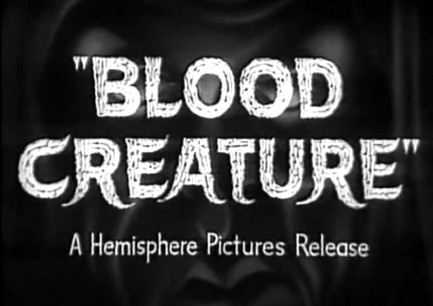 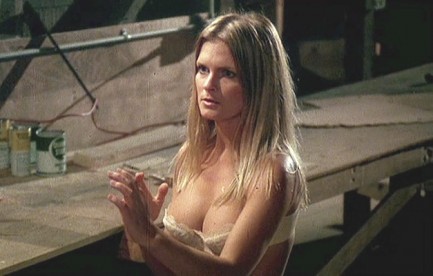  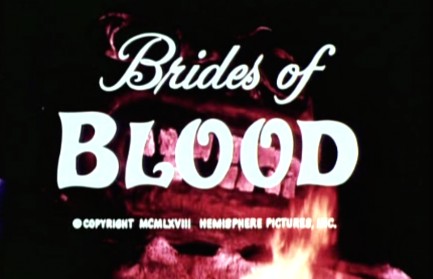 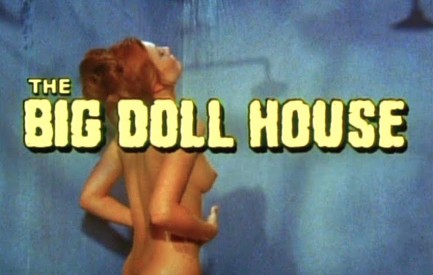 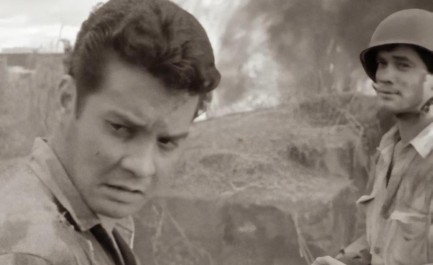 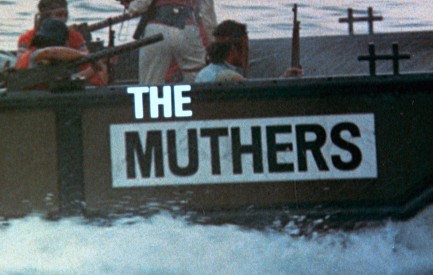 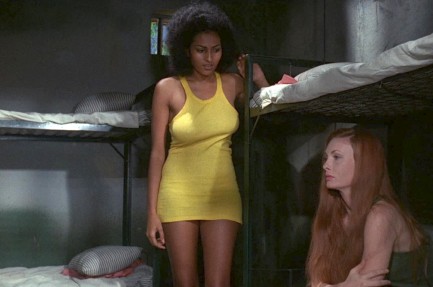 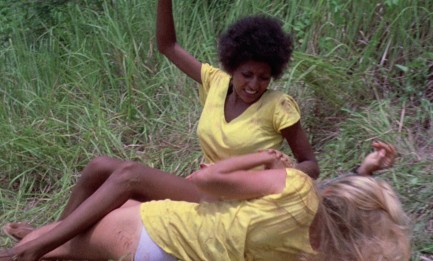 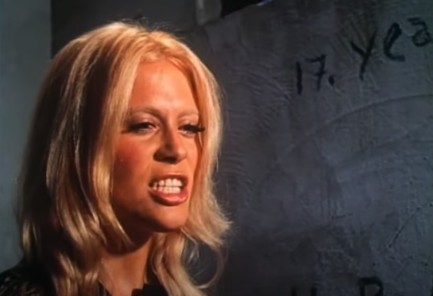 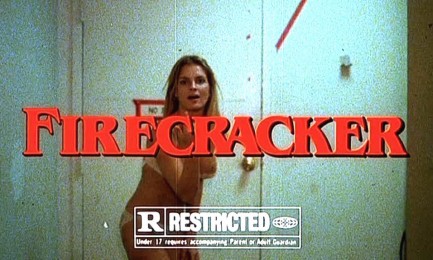  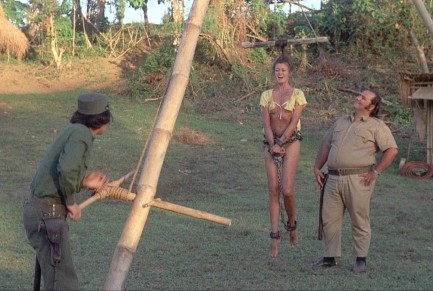    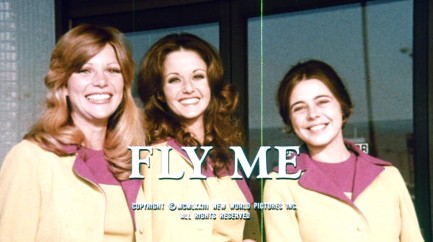 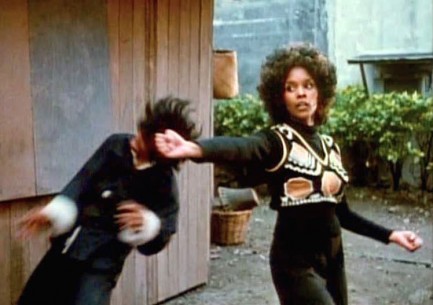 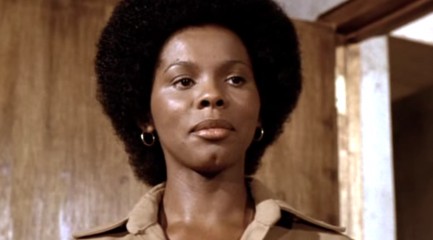  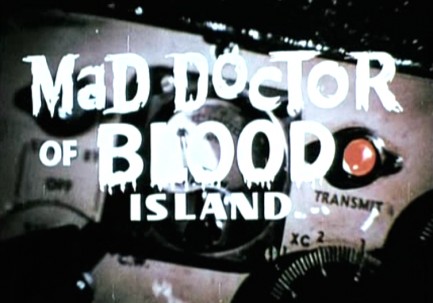 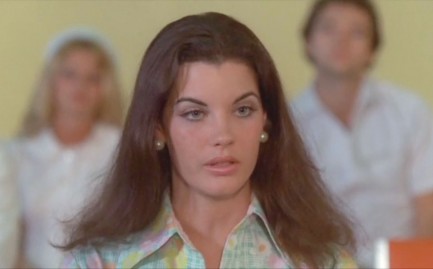 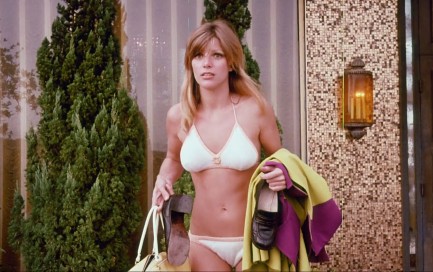 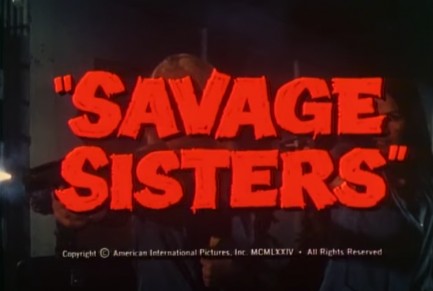  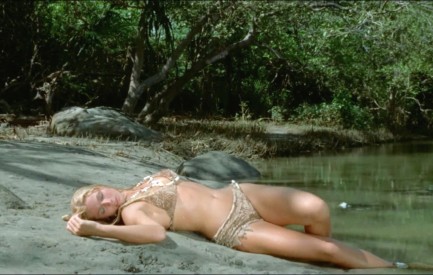 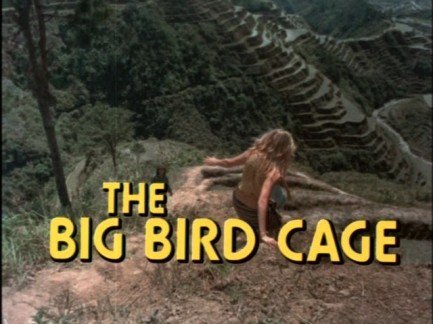 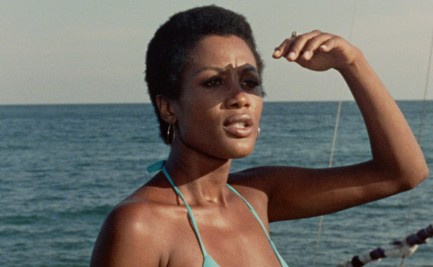 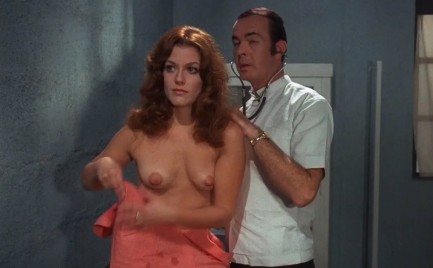 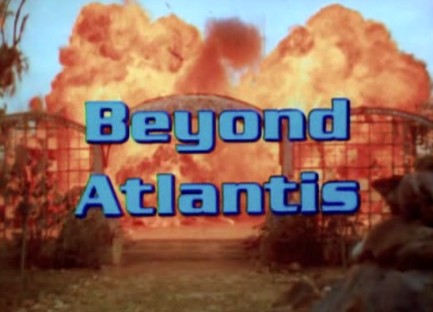 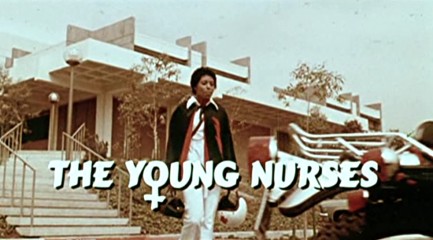 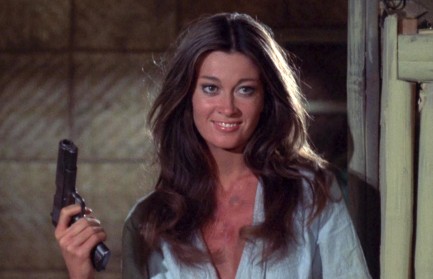
 Whatever floats your corpse. 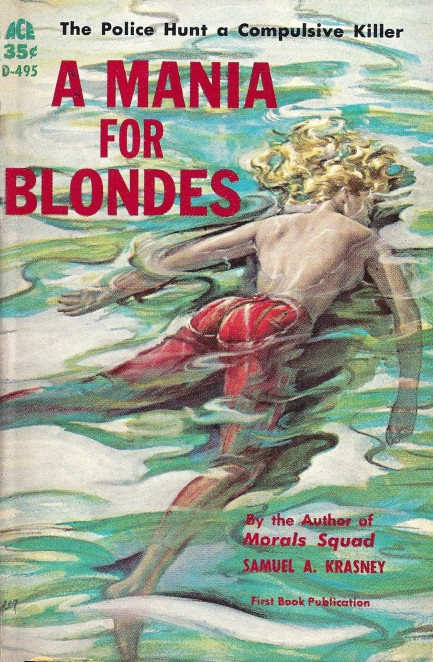
Art by Paul Rader fronts this copy of Samuel A. Krasney's A Mania for Blondes, a police proceedural dealing with two women drowned in Philadelphia's Delaware River, and the investigation to bring a killer to justice. The protagonist here is vice detective Ben Krahmer, who learns that both victims appeared in nudie reels. The clues lead down the rabbit hole of illicit porn and toward a mysterious suspect witnesses think looks like Zorro—but who Krahmer soon realizes may be a member of Pennsylvania's traditionally garbed Dutch community. Procedurals sometimes—as is the case here—fail to provide deep characterizations, but the mechanics of the investigation are interesting. Krasney constantly refers to his protagonist as “the Morals man”—capital M—which we found weird, but we thought this outing was solid overall and we liked the Zorro imagery. Even so, we probably won't go looking for more from Krasney unless we run across him cheap. There are, after all, so many paperbacks, and so little time.
 Hepburn brings a special kind of style to Hollywood. 
We don't smoke, but Katherine Hepburn sure makes smoking look good in this RKO promo photo shot by Ernest Bachrach in 1935. Though she had a long and storied career, this early shot is pretty much her iconic image. Prints of it are even sold on Wal-Mart's website. Hepburn is incomparable. Her must-watch films include Bringing Up Baby, Adam's Rib, The Philadelphia Story, The African Queen, Long Day's Journey into Night, The Lion in Winter, the groundbreaking Guess Who's Coming to Dinner (which inspired an excellent reggae song by Black Uhuru), and On Golden Pond. You can sum up Hepburn's output by saying she was nominated for a Best Actress Oscar twelve times and won a quartet, the most ever. The Oscar has failed to stay as relevant as it could have over recent decades, and the Academy has made some embarrassing Best Picture choices (Forrest Gump over Pulp Fiction—really?), but it's always been a reliable measure of acting quality, so Hepburn's four wins are meaningful. The one thing she didn't do was make a lot of pulp style movies. One that looks as if it qualifies is the 1946 drama Undercurrent. We'll circle back to that and the divine Miss H. in a bit.
 An afternoon on the South Side. 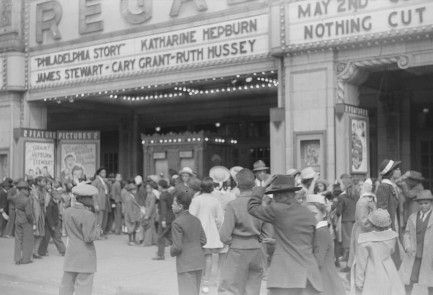 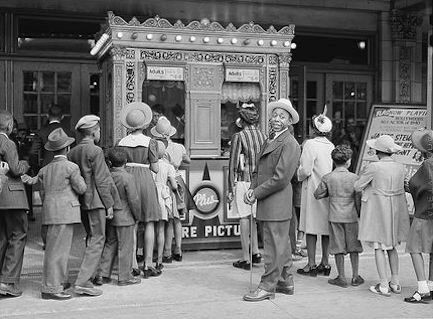 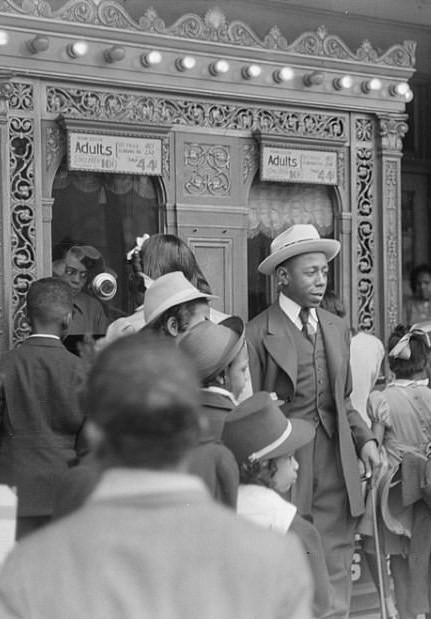
The above photos show the Regal Cinema in Chicago one afternoon during the spring of 1941 as locals flock to see The Philadelphia Story, starring Katherine Hepburn, James Stewart, and Cary Grant. The shots were made by Farm Security Administration photographer Edwin Rosskam, who had been tasked with documenting life in Chicago's black belt, which is where racist housing practices forced African Americans to live. Most of Rosskam's photos made abundantly clear that the underclass status forced upon blacks by redlining—the utilization of mortgage and insurance practices to hem them into tightly packed areas—led to less than desirable conditions, but many of his shots showed joyous moments and bustling civic life. These images of people decked out for a matinee are examples. They're part of the Office of War Information Collection maintained by the Library of Congress.
 My life has gone horribly wrong, but at least I still have my digni— Oh, great. My fly was open this whole time, wasn't it? 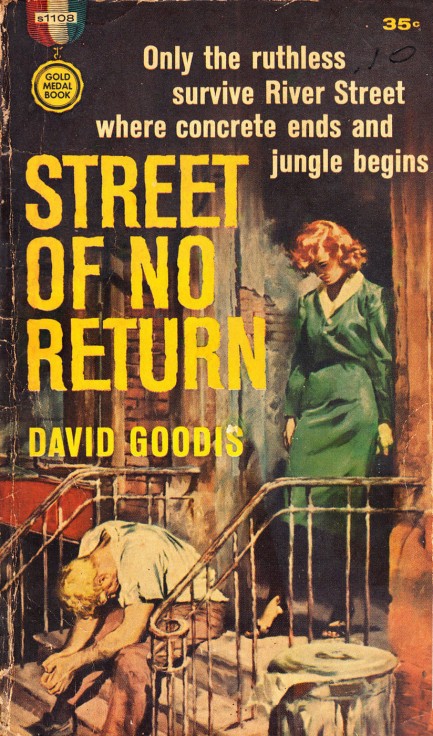
In David Goodis' 1954 thriller Street of No Return, a down-on-his luck nobody named Whitey, who had been a great singer years ago only to lose his voice, career, and sobriety—thanks to a dame, of course—finds that even for a man at rock bottom things can get worse. And it involves something more serious than discovering his fly is open, though that would be funny. What happens is an impulsive act of compassion drags him into a pit of murder and corruption, set against the backdrop of Puerto Ricans-vs-cops race riots in Philadelphia. There are plenty of reviews of this online, so for details just look around. This one caught our eye because of the intricate and gritty cover art, yet another top effort from Barye Phillips.
 What's in the box? Uh, you know, lipstick, gum, cigarettes, the souls of men I consume. The usual. 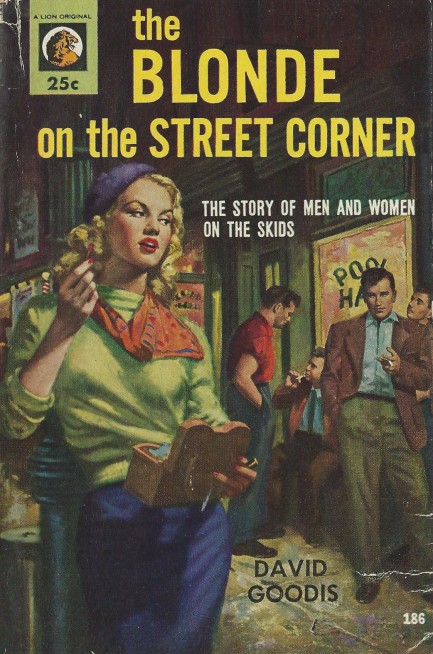 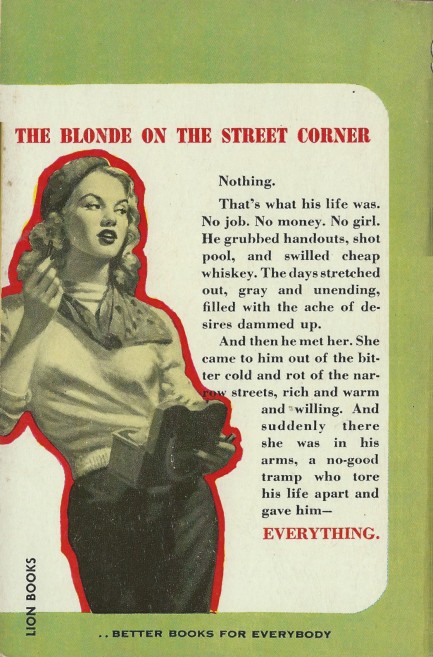
Above, really nice front and rear cover art for The Blonde on the Street Corner by David Goodis, which was published by Lion Books as a paperback original in 1954. Set in Philadelphia during 1936, the book examines a bunch of guys who have big dreams but no money, no motivation, and no ideas how to escape dead-end Philly. The narrative is basically plotless, like the characters' lives. Talk about a great depression. The cover art, by Robert Maguire, is beautiful but the blonde depicted is nothing like the blonde Goodis writes about. Goodis's blonde is overweight, married, and in her mid-thirties. She does have a sexual aura, though, and certainly fits the mold of a femme fatale. This is considered lesser Goodis, but it's still good enough.
 What do they expect? It's called the City of Brotherly Love. 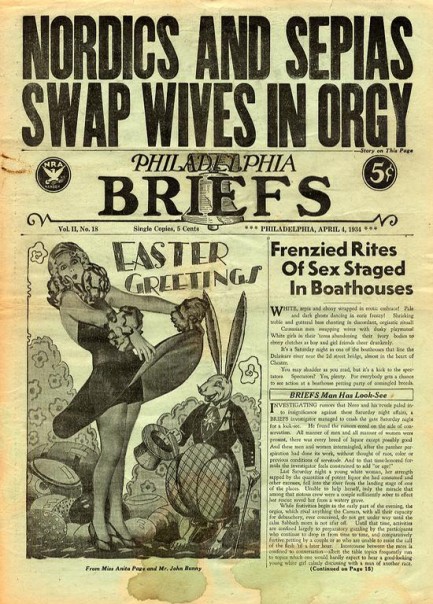
Above is a cover of the early tabloid Philadelphia Briefs published today in 1934, which caught our eye because it has a nice drawing of actress Anita Page, along with an Easter Bunny that seems to looking up her skirt. Bad, bad bunny. But it was added to the original shot, as you see below. Briefs was one of the purest early examples of the American tabloid form, with its reporting focused mainly on big city dangers faced by upstanding young white women, among those perils the predations of darker races—often referred to in the parlance of the Depression years as “sepias” or “ebonys.” To quote: “White, sepia, and ebony wrapped in erotic embrace. White girls in their teens abandoning their ivory bodies to ebony clutches as boy and girl friends cheer drunkenly.” Interesting, no? This style of reporting served a specific purpose. As James H. Adams put it in his book Urban Reform and Sexual Vice in Progressive Era Philadelphia, the goal was to, “demystify the city through the use of cultural archetypes and narratives that defined why the city was evil, the threat that the city posed to orderly society, and the measures that reformers needed to take to clean up the urban space.” In other words, Briefs created negative, often transparently ridiculous stories that had the effect of convincing readers that barriers maintaining the structure of contemporary society were under siege. These tales of white girls and brotherly love would distress many people even today, so you can imagine the outrage in 1934. See more Briefs here.
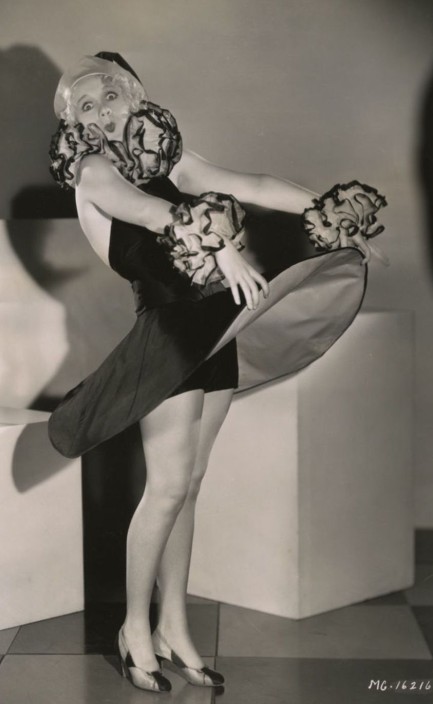
 San Francisco or bust? Looks like it was bust big time. 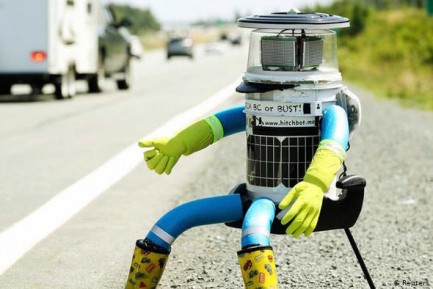
The odd photo you see above shows hitchBOT, a hitchhiking robot created by Canadian professors David Harris Smith and Frauke Zeller. It can't move on its own. It's programmed to respond to human voices, have rudimentary conversations, ask for rides, and post updates to the internet. Good samaritans take hitchBOT as far as they want, then leave it where it can catch another ride. In this way the bot successfully made three separate cross country journeys the breadth of Canada, Germany, and the Netherlands. But here's the thing—“cross country” has a whole different meaning in the U.S., where there may be more cross people per capita than anywhere else on Earth. Is it any surprise that when sent to traverse America hitchBOT was murdered almost before its journey began?
It had been tasked with traveling from Boston to San Francisco, but made it only to Philadelphia before being decapitated and gutted. It was a sad end for the well-traveled and kind-hearted hitchBOT. More of a sociological experiment than a science undertaking, it essentially relied on human kindness to get around, and found it sorely lacking in America. Maybe you're surprised how hitchBOT's travels  concluded, but in our opinion ending up shattered on a Philly roadside was entirely predictable. Hell, we've ended up shattered on a roadside a few times, and we have every possible human advantage. Poor hitchBOT hadn't a prayer. concluded, but in our opinion ending up shattered on a Philly roadside was entirely predictable. Hell, we've ended up shattered on a roadside a few times, and we have every possible human advantage. Poor hitchBOT hadn't a prayer.
But before you jump to the conclusion that Canadian college professors are hopelessly naive, note that hitchBOT was programmed for the possibility his travels would be cut short. His final update was, “Oh dear, my body was damaged, but I live on back home and with all my friends. I guess sometimes bad things happen to good robots! My trip must come to an end for now, but my love for humans will never fade. Thank you to all my friends.” So it's clear that Smith and Zeller anticipated their bot dying. We're not sure if they anticipated the sheer viciousness of its demise, but it's okay because like hitchBOT said, all its data is safe back in Canada, which means it can be downloaded into another robotic shell.
But why bother? Subsequent trips to the U.S. would surely end with it being obliterated in increasingly baroque ways. Wrapped in chains and dumped in a river comes to mind as a possibility. Doused in gasoline and set afire in a Walmart parking lot is also likely. Deliberately flattened on the freeway shoulder by someone driving a shitbox they don't mind damaging a bit also could easily happen. Or possibly just riddled with .45 bullets until there's nothing left but unrecognizable debris and a hitchin' thumb. Well, we'll see if hitchBOT has more journeys, but if we had to guess, we'd say Smith and Zeller learned everything they need to know—that their neighbors to the south are monsters. 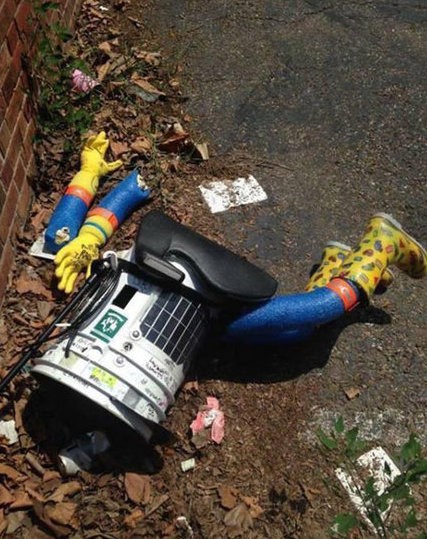
 Good aim is helpful for committing murders, and absolutely crucial for solving them. 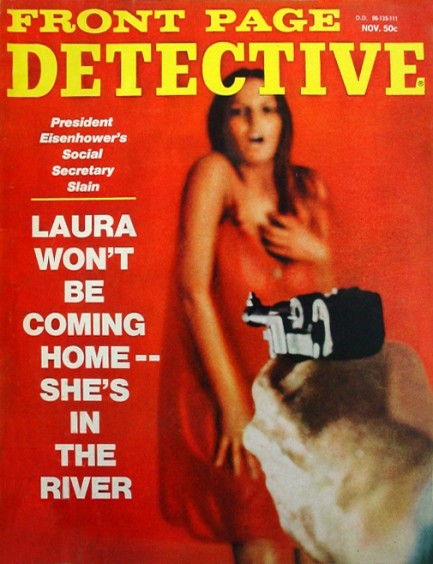
Front Page Detective shows on this November 1971 cover how to attract eyeballs with lurid art and titillating text. Eisenhower’s social secretary murdered? That sounds intriguingly political, but it turns out Eisenhower’s only connection is that his White House had more than a decade earlier employed the murder victim in a secretarial position. Though no political angle exists, the crime itself is still very interesting. Laura Carpi, scion of a prominent Philadelphia family, disappeared in February 1971. In June the decomposed body of a woman was found in New York City’s East River, labeled an accidental drowning victim, and twenty days later interred on Hart Island as a Jane Doe in the potter’s field there. After the body was identified as Carpi’s, the New York Times published a sensational story claiming that her head had been removed before burial for study by junior pathologists, or, according to some sources in the pathologist’s office, simply to be used as a desk ornament. The Times claimed that a technician had been cleaning out whatever grisly remnants of flesh were still attached to the skull and happened to find a bullet lodged in its neck tissue. Dealing now with a suspected homicide, police focused on missing persons, and eventually summoned Carpi’s dentist. Recognizing his own work, he made the positive identification. The ME’s office became the center of a storm, with Chief Medical Examiner Milton Helpern blasting the Times story for insinuating that “the doctors in this office are cutting off people’s heads to make ashtrays.” He pronounced the entire article “grossly distorted.” Perhaps it was, but uncovering a murder by chance never looks good, and he didn’t help his cause when he responded to a question about why his staff had failed to discover the bullet by saying that he ran a mortuary, not a graveyard, and was extremely busy. Though his answer was callous, it was also correct. His office had a contant flow of bodies coming through—that year more than 1,800 alone that had been victims of murder—and his staff was overworked. Add to this the facts that Laura Carpi had thick hair that concealed the small caliber entry wound at the base of her skull, the slug had left no exit wound, and the head had been four months in the water, and it’s possible to see how mistakes could be made. As to why the head was kept, the unconvincing official reason was that it was because the dentalwork would allow for possible future identification—which only made sense if all the Jane and John Does on Hart Island were also headless.
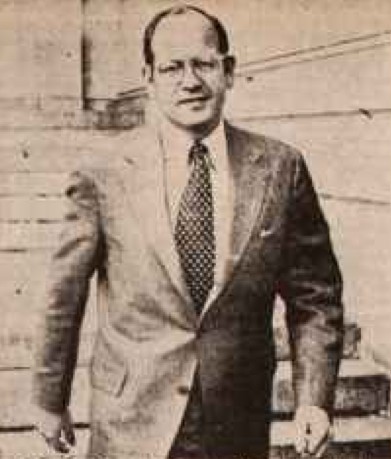 In any case, the finger of suspicion for the murder immediately pointed toward Carpi’s estranged husband Colin, at right, who was battling for custody of their four children. Not only would the loss of this battle and subsequent divorce settlement wipe him out financially, but he was also well aware that his wife had been seeing another man. For various reasons—jurisdictional issues and general reluctance to pursue the crime—Colin Carpi didn’t go to trial for two more years. A mountain of circumstantial evidence pointed at him, but his acquittal was deemed by most legal experts to be the right decision. The prosecution simply bungled its presentation to the jury, and even if the courtroom aspect had been perfect, much of Colin Carpi’s suspicious behavior could be chalked up to the circumstances around the custody battle and his wife’s affair. Perhaps a not-guilty verdict was an anti-climax after the high drama associated with the identification of Laura Carpi’s body, but not finding the perp is the way it often goes in true crime, and real life. In any case, the finger of suspicion for the murder immediately pointed toward Carpi’s estranged husband Colin, at right, who was battling for custody of their four children. Not only would the loss of this battle and subsequent divorce settlement wipe him out financially, but he was also well aware that his wife had been seeing another man. For various reasons—jurisdictional issues and general reluctance to pursue the crime—Colin Carpi didn’t go to trial for two more years. A mountain of circumstantial evidence pointed at him, but his acquittal was deemed by most legal experts to be the right decision. The prosecution simply bungled its presentation to the jury, and even if the courtroom aspect had been perfect, much of Colin Carpi’s suspicious behavior could be chalked up to the circumstances around the custody battle and his wife’s affair. Perhaps a not-guilty verdict was an anti-climax after the high drama associated with the identification of Laura Carpi’s body, but not finding the perp is the way it often goes in true crime, and real life.
 Yeah, but you should see the other guy. 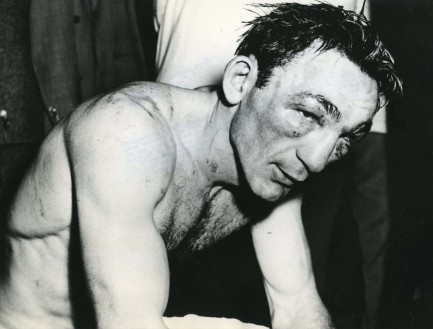
This is American boxer Carmen Basilio, and bad as he looks on the outside, he feels even worse inside because he’s just learned he lost his welterweight title to challenger Johnny Saxton. That wasn’t what Basilio, the crowd of thousands, and the television audience of millions thought when the final bell rang, but the judges somehow saw a different fight than everyone else and awarded Saxton the decision. Did it have anything to do with the fact that Saxton was mafia-connected, and his “manager, friend, and adviser” was Philly mobster and notorious fight fixer Frank “Blinky” Palermo? Very possible. Basilio later said of the decision, which occurred in March 1956, “It was like being robbed in a dark alley.” Well, he certainly looks like a guy who was robbed. See more on Basilio here.

|
 |

The headlines that mattered yesteryear.
2003—Hope Dies
Film legend Bob Hope dies of pneumonia two months after celebrating his 100th birthday. 1945—Churchill Given the Sack
In spite of admiring Winston Churchill as a great wartime leader, Britons elect
Clement Attlee the nation's new prime minister in a sweeping victory for the Labour Party over the Conservatives. 1952—Evita Peron Dies
Eva Duarte de Peron, aka Evita, wife of the president of the Argentine Republic, dies from cancer at age 33. Evita had brought the working classes into a position of political power never witnessed before, but was hated by the nation's powerful military class. She is lain to rest in Milan, Italy in a secret grave under a nun's name, but is eventually returned to Argentina for reburial beside her husband in 1974. 1943—Mussolini Calls It Quits
Italian dictator Benito Mussolini steps down as head of the armed forces and the government. It soon becomes clear that Il Duce did not relinquish power voluntarily, but was forced to resign after former Fascist colleagues turned against him. He is later installed by Germany as leader of the Italian Social Republic in the north of the country, but is killed by partisans in 1945.
|

|
|

It's easy. We have an uploader that makes it a snap. Use it to submit your art, text, header, and subhead. Your post can be funny, serious, or anything in between, as long as it's vintage pulp. You'll get a byline and experience the fleeting pride of free authorship. We'll edit your post for typos, but the rest is up to you. Click here to give us your best shot.

|
|


 discussed often fall into the category of sexploitation, at the time they were also considered an adjunct of the women's liberation movement—a point made by a couple of the actresses interviewed. Coming out of the sexually repressive decades of the fifties and early sixties, nudity was seen as a rebuke to patriarchal control.
discussed often fall into the category of sexploitation, at the time they were also considered an adjunct of the women's liberation movement—a point made by a couple of the actresses interviewed. Coming out of the sexually repressive decades of the fifties and early sixties, nudity was seen as a rebuke to patriarchal control.
 want to outrage, or teach, or push censorship envelopes, or illuminate themes that leave audiences enriched in some way, but it's still just a job they perform before going home to their real lives. We wouldn't be surprised if some of the interviewees now feel they'd been traumatized, but during this movie, at least, they shrug off the difficulties of filming—ranging from extreme weather to graphic nudity to military revolt—as obstacles true professionals must navigate.
want to outrage, or teach, or push censorship envelopes, or illuminate themes that leave audiences enriched in some way, but it's still just a job they perform before going home to their real lives. We wouldn't be surprised if some of the interviewees now feel they'd been traumatized, but during this movie, at least, they shrug off the difficulties of filming—ranging from extreme weather to graphic nudity to military revolt—as obstacles true professionals must navigate.

















































 concluded, but in our opinion ending up shattered on a Philly roadside was entirely predictable. Hell, we've ended up shattered on a roadside a few times, and we have every possible human advantage. Poor hitchBOT hadn't a prayer.
concluded, but in our opinion ending up shattered on a Philly roadside was entirely predictable. Hell, we've ended up shattered on a roadside a few times, and we have every possible human advantage. Poor hitchBOT hadn't a prayer.


 In any case, the finger of suspicion for the murder immediately pointed toward Carpi’s estranged husband Colin, at right, who was battling for custody of their four children. Not only would the loss of this battle and subsequent divorce settlement wipe him out financially, but he was also well aware that his wife had been seeing another man. For various reasons—jurisdictional issues and general reluctance to pursue the crime—Colin Carpi didn’t go to trial for two more years. A mountain of circumstantial evidence pointed at him, but his acquittal was deemed by most legal experts to be the right decision. The prosecution simply bungled its presentation to the jury, and even if the courtroom aspect had been perfect, much of Colin Carpi’s suspicious behavior could be chalked up to the circumstances around the custody battle and his wife’s affair. Perhaps a not-guilty verdict was an anti-climax after the high drama associated with the identification of Laura Carpi’s body, but not finding the perp is the way it often goes in true crime, and real life.
In any case, the finger of suspicion for the murder immediately pointed toward Carpi’s estranged husband Colin, at right, who was battling for custody of their four children. Not only would the loss of this battle and subsequent divorce settlement wipe him out financially, but he was also well aware that his wife had been seeing another man. For various reasons—jurisdictional issues and general reluctance to pursue the crime—Colin Carpi didn’t go to trial for two more years. A mountain of circumstantial evidence pointed at him, but his acquittal was deemed by most legal experts to be the right decision. The prosecution simply bungled its presentation to the jury, and even if the courtroom aspect had been perfect, much of Colin Carpi’s suspicious behavior could be chalked up to the circumstances around the custody battle and his wife’s affair. Perhaps a not-guilty verdict was an anti-climax after the high drama associated with the identification of Laura Carpi’s body, but not finding the perp is the way it often goes in true crime, and real life. 






































































